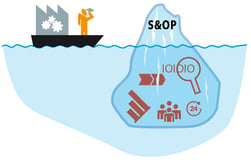What Makes an S&OP Process Successful?
Brian Hoey - June 04, 2020

When a particular business process isn’t yielding the results you want, there’s always something of a chicken and egg question: is your quarterly S&OP meeting, for instance, failing to have measurable results on your supply chain efficiency because individual department heads don’t take it seriously—or are department heads failing to take it seriously because it hasn’t produced any measurable results? The best way out of conundrums like this is to avoid getting into them in the first place, but for businesses that might be struggling to extract value out of their current S&OP cycle, it’s never too late to make adjustments.
Before you can make those adjustments, you need to know what it is that makes S&OP workflows successful in the first place. Sure, it’s easy to imagine what a well-run planning process might look like from the outside—one that’s data-driven, well-integrated with other critical business functions, and adaptable to new situations—but how do you actually get to that point?
Promoting Visibility
First things first, successful S&OP processes rely on high levels of visibility. Though the backbone of the process is data collection and analysis (more on that later), its success or failure is ultimately decided by the human planners who use that data to align on goals and strategy—which means that it’s mission critical for everyone to have access to planning and forecasting information from every touch point on the value chain. This is partially a matter of collecting the right data—which might include historical and current orders, inventory stock levels, throughput metrics for particular production schemes, etc.—but it’s also a matter of reducing silos and making sure that everyone is able to easily access the data they need, when they need it. If a production planner has to go into a meeting without having been able to get a sense of inventory level fluctuations beforehand, she’ll have a hard time presenting an accurate overview of current production capacity. This is in part a technological problem: Are you offering stakeholders the tools they need for successful communication and collaboration? Do you have a shared platform that offers comprehensive views of the entire supply chain for a given planning horizon? But it’s also an organizational problem—meaning that success depends on making end-to-end visibility a guiding philosophical principle for every decision.
Choosing the Right Tools
We mentioned above that achieving end-to-end visibility (a necessary prerequisite for planning success) is partially about choosing tools that reduce silos and make collaboration easy. But what tools should you be utilizing, and how can you make sure you’ve chosen the right ones? Since S&OP is fundamentally a software-driven process, your first step is to choose the right S&OP software. Sure, you could try to do the job with an Excel spreadsheet, but it would inevitably lead to information silos and your analytics capabilities would be severely limited. With the right S&OP solution, on the other hand, you could automatically import data from sources up and down the value chain, and then visualize that data based on your selected parameters and planning horizons. From there, you should be able to run advanced analytics algorithms to turn that data into smart, rolling forecasts that are more accurate than anything you could have achieved by hand. Based on those forecasts, you can then visualize your ability to meet demand and adjust your capacity as needed. Again, make sure you’re privileging visibility and transparency with whatever options you’re considering.
Setting the Right Planning Horizon
Speaking of parameters and planning horizons: There’s plenty of variation in the length of time that S&OP processes purport to cover, ranging from about 3-6 months to as long as 18 months. This variation makes sense, since there’s also a fair bit of variation from one manufacturing outfit to another in terms of production and sales cycle times, order lead times, and the time needed to increase capacity in response to new demand realities. As such, the right planning horizon for your company will depend on a combination of those factors. If, for instance, your production and inventory planners are working with four month-long lead times for making the necessary adjustments to expand or reduce capacity, having an S&OP cycle that only covers 3 months is going to be effectively useless. Why? Because by the time your production and inventory planners have adapted to demand expectations, those expectations are already out of date. By contrast, if your outfit is comparatively lean, you may want to shorten your planning horizon so that you can be more adaptable to disruptions and fluctuations in demand levels over time. Of course, your S&OP software should be able to give you any planning horizon you need at the push of a button—including rolling contingencies for different demand and capacity scenarios—so this is another factor that’s about being adaptable from an operational perspective and relying on your technology to support you.
Improving Your Forecasts
Of course, none of the factors we’ve discussed above are going to add value to your S&OP process if your forecasts are still inaccurate. After all, it doesn’t matter how effectively you adjust your capacity to new demand realities if those realities never materialize. Of course, the entire point of S&OP in the first place revolves around improving your forecasts, but the simple fact is that there are limits to what a human planner with a pen and paper or a spreadsheet can do. This is why it’s imperative that your forecasting tools both within the S&OP process and at other touch points on the value chain be equipped with advanced analytics capabilities. In this way, you can analyze more data than ever before (which you can and should collect using supply chain integration, the internet of things, and other methods), thereby boosting the accuracy of your predictions. And this isn’t just your demand forecasts, by the way—on the contrary, analytics integration can help you predict future price fluctuations, disruptions, parts shortages, and much more. If S&OP is all about gathering knowledge and using it to become better prepared for what’s coming down the pike, it’s hard to think of a better way to extract real, operational value from that gathered knowledge.
If you want to learn more get your Guide to Sales & Operations Planning
In this Guide you will learn:
-
Why a S&OP Process is important
-
How a S&OP System can be flexible and quickly implemented
-
Central tasks of a S&OP System
-
The key to more productivity
LATEST POSTS
- Understand Why Production Planning Needs Specialized Solutions
- Understand Circular Economy in The Manufacturing Industry
- How Can Industry 4.0 IT Integration Be Achieved Smoothly?
- The Significance of Order Sequencing in Discrete Manufacturing
- How to improve your Supply Chain Management: The Power of Control Towers



